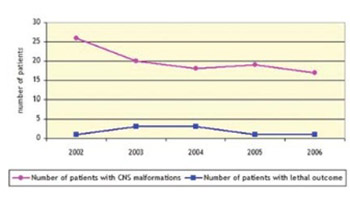Congenital Malformations of the Central Nervous System: Clinical Approach
DOI:
https://doi.org/10.17305/bjbms.2008.2897Keywords:
central nervous system malformations, prevention, prenatal diagnosisAbstract
Central nervous system (CNS) malformations represent important factor of morbidity and mortality in children.
The aim of the study was to determine the incidence, type and clinical features of CNS malformations in children who were admitted at the Neonatal and Child Neurology Department, Neonatal Intensive Care Unit and Paediatric Intensive Care Unit of Paediatric Clinic, University of Sarajevo Clinics Centre, from January 1st, 2002 to December 31st, 2006.
There were total of 16520 admissions at the Paediatric Clinic over the studied period. CNS malformations, solitary or multiple, have been diagnosed in 100 patients (0,61%). The total number of various CNS malformations was 127. Lethal outcome was established in 9/100 cases (9%). The most frequent CNS malformations were neural tube defects 49/127 (38,6%). Hydrocephalus was seen in 34/127 (26,8%), microcephaly in 24/127 (18,9%), agenesis of corpus callosum in 10/127 (7,9%), Dandy Walker malformation in 6/127 (4,7%) and other CNS malformations in 4/127 (3,1%). In 20/100 of patients neural tube defect was associated with hydrocephalus (20%). CNS malformations were prenatally diagnosed in 13/100 of patients (13%).
Primary prevention of CNS malformations can be improved in our country by better implementation of preconceptional folic acid therapy for all women of childbearing age. Secondary prevention by prenatal diagnosis requires advanced technical equipment and adequate education of physicians in the field of foetal ultrasonography. In our circumstances, prenatal diagnostics of CNS malformations is still not developed enough.
Citations
Downloads

Published
Issue
Section
Categories
How to Cite
Accepted 2017-12-27
Published 2008-11-20









